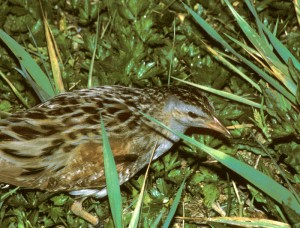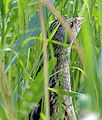
The Corncrake is not the most charismatic bird in the world – a Moorhen-like bird that lives in long grass, has a rasping ‘song’ (crex! crex!) which it mostly sings at night and looks like it finds getting airborne difficult, but which flies to the other side of the Sahara every year (and back of course). Actually, now I write that, it seems to have a certain something about it.
But this year it was crex-ing away in bigger numbers than usual – the biggest numbers since records began of detailed counts, 45 years ago. Of course, the Corncrake was a common bird right across the UK until modern farming, but this was early 2oth century farming, (that was modern enough), scrunched up so many of its eggs and black fluffy young that its population tumbled.

But now the crexing corncrake is a conservation success story. Thanks to research, management trials and the rolling out of well-tested conservation measures (the right mix of grants to farmers and nature reserves), the Corncrake numbers, despite falling in 2013, have bounced right back in 2014 to 1,289 singing males in Scotland. It’s a record! It’s almost certainly the most there have been in my lifetime.
Nearer to home, the reintroduction project on the Nene Washes about which I tend to write at least once a year (eg 2009, 2010, 2014), has had a record year too. Woohoo! In the Cambridgeshire Fens there were 22 singing males compared with just 7 last year (the previous year had been a disaster with flooding of the Washes). That’s the most ever and there is a record number of home-bred birds in that total (as compared with reared and released birds) which is a good sign for the future too.
These projects are long and difficult – they require great skill and knowledge to pull off – but when they look like they will work it’s a great reward.
[registration_form]
I saw my first ever on Iona last May, wonderful! So glad they are doing well.
Kate – good for you. In 1900 they bred in every county in UK. But their massive decline has been turned around.
But I thought the RSPB only cared about raptors and do nothing else for no other species! ‘ )
Ben – whoever told you that?!
Excellent news. I wont believe they exist though until I see one (hopefully next spring in the Uists).
The question that niggles me a bit though is if in Scotland they exist on dry(ish) croft land, there must be other land around the UK where it is suitable for them nowadays. The Nene Washes experiment has proved itself, why has it not continued elsewhere.
Apparently only one ringed Scottish breeding corncrake has ever been recovered from its wintering ground in Africa Corncrakes SNH pdf
I believe that a recent project with geolocators on Coll has found that one bird was overwintering in the Congo, a previously unknown site. It would be interesting to know the routes of the birds through Scotland and England so that reintroduction programs could then be undertaken along these routes.
Spreading farmyard manure around field edges and allowing nettles and cow parsley to colonise and form some tall cover early in the year has helped enormously in building up corncrake numbers
Great news. Like Kate I was lucky enough to hear (and see very clearly!) my first ever Corncrake on Iona last year. Also saw my first Hen Harrier on Mull on the same holiday, what a wonderful bird. Sickens me to hear recently yet again 2 more Harriers “lost” in Bowland. Have signed petition and bought Hen Harrier T shirt but was sorry not to make protest day as fully booked up (which was good news!) by the time I became aware of it. Will try and make it next year if another Hen Harrier day is planned. Keep up the good work Mark.